India’s rural super rich are growing faster than the urban rich
By 2030-31, the number of super rich households in India is expected to rise by five times to 9.1 million households, and by 2046-47 this is expected to go up to 32.7 million households, according to people Research on India’s Consumer Economy (PRICE), an independent, not-for-profit think-tank.
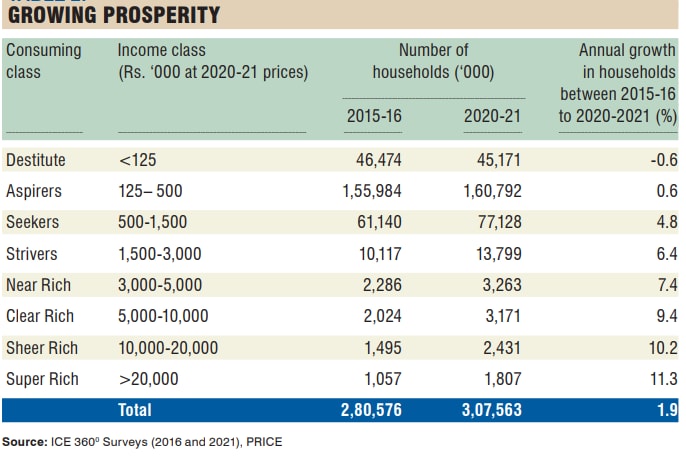
The report is based on analysis of primary data collected by PRICE through its ICE 360° pan-India survey. The latest survey is based on 40,000 households from 25 Indian states.

” The number of Super Rich, earning more than Rs 2 crore in 2020-21, has gone up from 1.06 million households (6.1 million consumers) in 2015-16 to 1.81 million households (10.2 million consumers) in 2021. This works out to an annual growth of 11.3 per cent. By 2030-31, the number of Super Rich households is expected to increase even faster, to 9.1 million households (46.7 million consumers), and by 2046-47 this is expected to go up to 32.7 million households (150 million consumers),” said the report.
While Mumbai and Delhi have a high concentration of rich households, rich households are growing at a more hectic pace in boom towns such as Surat, Bangalore, Ahmedabad and Pune. In fact Surat and Nagpur have witnessed the highest growth, in the high-income segment. And Maharashtra has the largest concentration of ‘Super Rich”.
.
The overall category of the Rich, or those with family income of over Rs 30 lakh in 2020-21, is estimated at about 11 million households comprising 56 million consumers, compared to nearly 7 million households with 37 million consumers in 2015-16. By 2030-31, this will go up to 35 million households with 170 million consumers. And by 2046-47, the number will grow to 100 million households.
Rural Super Rich growing faster than Urban Super Rich
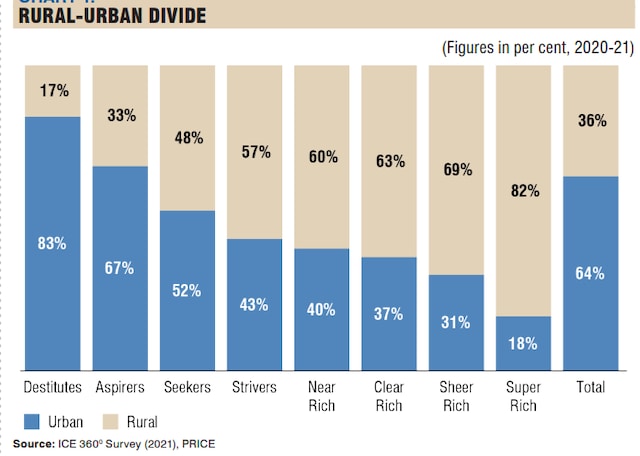
For househholds with income of Rs 2 crore-plus), the annual growth in urban areas between 2015 and 2021 was 10.6 per cent compared to 14.2 in rural areas. Similarly, for the Sheer Rich (households with income of Rs 1 crore to Rs 2 crore), annual urban growth was 9.4 per cent compared to 12 per cent for rural areas.
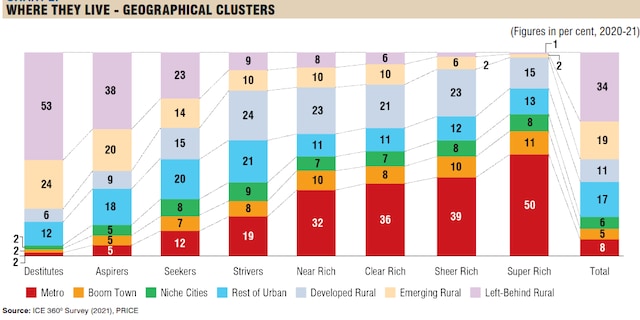
Though western states have the highest per capita incomes, the biggest growth has been in the central, followed by the north-eastern states and most of these changes are taking place in rural India and semi-urban India.
Apart from the fact that the west has the highest number of Super Rich (8.03 lakh households versus 3.94 lakh for the northern states), the western states have the highest ‘density’ of the rich — that is, the share of rich households in the zone.
44 percent of India’s super rich live in the West
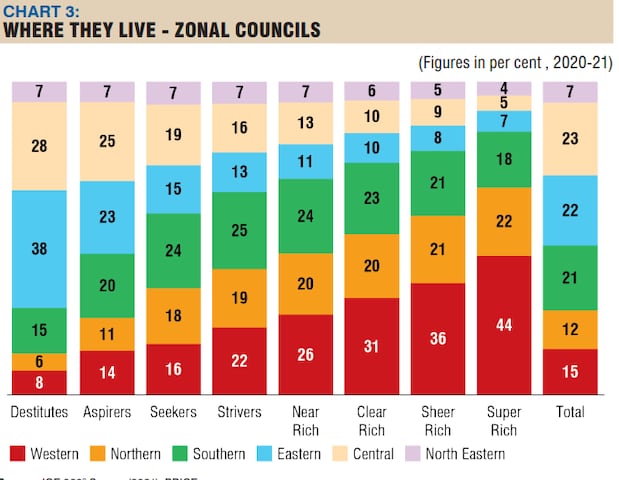
States with the highest concentration of super rich
India’s ten richest states
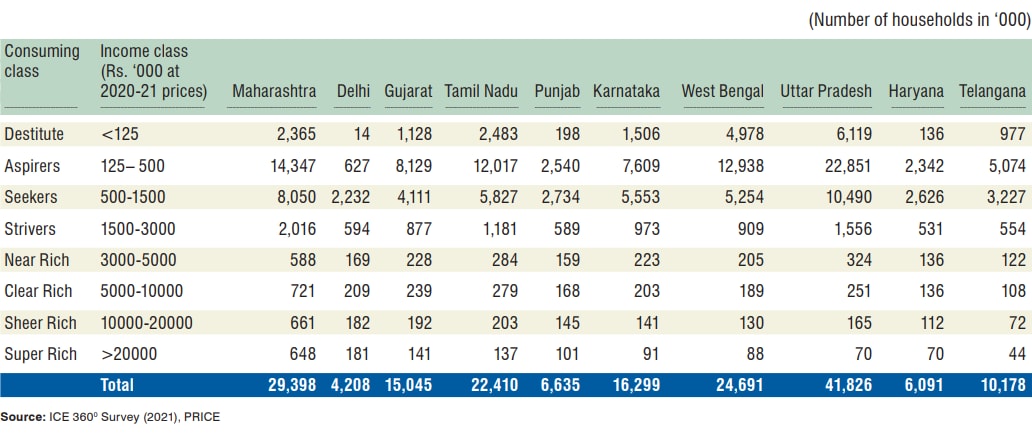
Close to half of India’s Super Rich live in Maharashtra and Delhi. These five states account for 57 per cent of the Sheer Rich, 51 per cent of the Clear Rich and 44 per cent of the Near Rich.
The poorest five states — Bihar, Uttar Pradesh, West Bengal, Madhya Pradesh, and Odisha — account for about 40 per cent of total households in 2020-21 and are home to nearly 56 per cent Destitute households and only 11 per cent Super Rich.
Over three-fourths of India’s rich live in just eight states — Maharashtra, Tamil Nadu, Uttar Pradesh, Gujarat, Delhi, Karnataka, West Bengal and Punjab.
According to the report, the middle-class will make up 1.02 billion of India’s projected population of 1.66 billion by 2047. That’s the year that marks 100 years of India’s independence and its target to emerge as a developed nation.
PRICE defines a middle-class Indian as one earning between Rs 1.09 lakh and Rs 6.46 lakh per year in the 2020-21 prices. However, there is no universal definition of who falls in the coveted middle-class.
PRICE found that even if the absolute income is higher among the rich, but the numerical strength of the Indian Middle Class suggests that it will become the driving force of the Indian economy, while its aggregate purchasing power will result in the creation of India as one of the largest markets in the world.
“The survey indicates that the middle class is the fastest growing major segment of the Indian population, both in terms of percentage and absolute terms. It is necessary to understand why middle class is important because half of the income, expenditure and saving is with this section. Moreover, 55% of the incremental consumption by 2031 will be by the middle class,” said Dr. Rajesh Shukla, Managing Director and CEO of PRICE .
It is also estimated that the population of the destitute (less than ‘1.25 lakh annual income) and aspirer groups (Rs 1.25-5 lakh) will correspondingly decrease from almost 928 million in 2020-21 to 647 million by 2030-31 and further to 209 million by 2046-47.
Less than 2% of the country’s destitutes live in India’s top 63 million plus population cities versus 98% in the rest of India. And, despite their low population share, 55% of the country’s Super Rich, 44% of the Sheer Rich, 42% of Clear Rich, 37% of Near Rich and 27% of the Middle Class in live these cities.
How the rich and the middle class earn and spend
The Middle Class category, comprising 432 million people whose annual household income is in the Rs 5 lakh to Rs 30 lakh range has a total household income of Rs 84,120 billion, and spending of Rs 62,223 billion in 2020-21. The
Middle Class saved about Rs 11,774 billion during 2020-21. As a group, the household income is more than twice the earning of the Rich category (56 million people, earning at the average annual rate of more than Rs 30 lakh) pegged at Rs 38,239 billion.
In spending terms, the Middle Class spends a little less than three times that of the Rich category. The report found that the middle class group is the country’s biggest contributor in terms of income (50 per cent), expenditure (48 per cent) and savings (52 per cent).
The share of rich population is about 4 per cent but contribute 23 per cent of household disposable income, 17 per cent of expenditure and a lion’s share in saving (29 per cent).
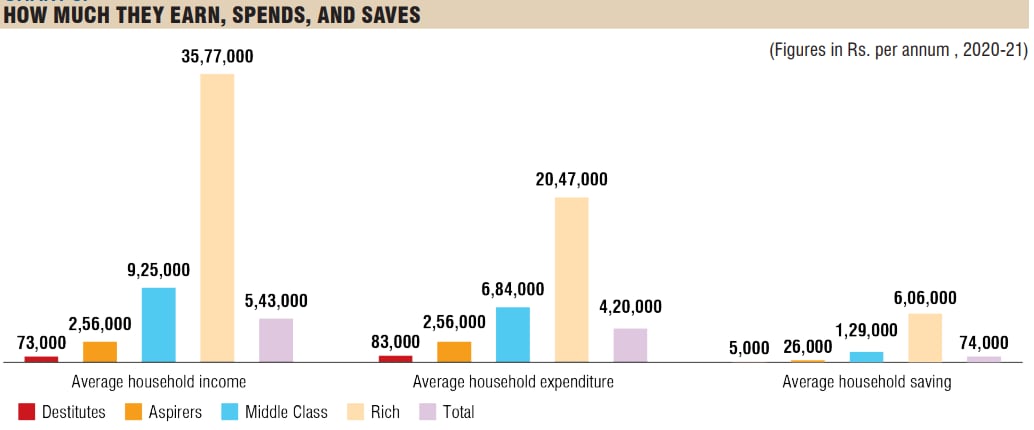
As seen in the above table, expenditure levels for the Middle Class household group stands at Rs 6.86 lakh per annum in 2020-21, Rs 20.47 lakh for the Rich income group and Rs 82,300 for the Destitute household group respectively.
Rich households spend considerably more on holiday trips, consumer durables and higher education. In contrast, Destitute households spend more on upgrading and repair of their houses.
Food and shelter continue to be major considerations for Destitute households. Health spending and marriage are also considerable spends.
The huge inequality that exists between the poorer households and the top is evident when you consider the annual average spending. A rich household spends Rs 20.47 lakh annually which is almost twenty-five times that of a Destitute household (Rs 82,300), eight times that of Aspirer household, and almost three times that of a Middle Class household.
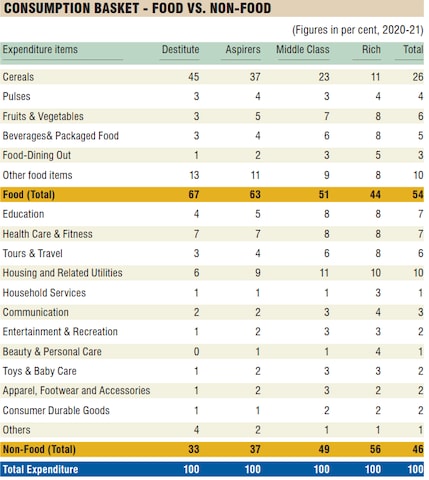
Food spend share for Rich households stands at 44 per cent. The shares for Destitute and Aspirer households are 67 per cent and 63 per cent respectively. It’s evident that poorer income households are spending a major part of their earnings on food, healthcare, and housing. Rich household group’s share of education expenditure is highest at 8 per cent.
 Loan, Personal Loan, Home Loan, Business Loan,Loans in India Loan in India, Personal Loan, Home Loan, Business Loan, Loans in India,Loan Finance,Loan in India, Get Instant Personal Loan,Home Loan, Business Loans in India
Loan, Personal Loan, Home Loan, Business Loan,Loans in India Loan in India, Personal Loan, Home Loan, Business Loan, Loans in India,Loan Finance,Loan in India, Get Instant Personal Loan,Home Loan, Business Loans in India